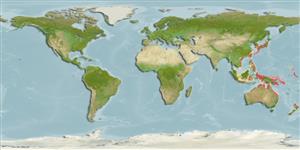Bivalvia |
Arcida |
Noetiidae
Environment: milieu / climate zone / গভীরতার পরিসীমা / distribution range
বাস্তুসংস্থান
; গভীরতার পরিসীমা 0 - 20 m (সূত্র 348). Tropical
Western Pacific and Indian Ocean: from Japan and China to the Philippines and northern Australia.
Length at first maturity / আকৃতি / Weight / Age
পরিপক্কতা : Lm ? range ? - ? cm Max length : 3.5 cm SHL পুরুষ/ লিঙ্গ অনিধর্ারিত ; (সূত্র 348); common length : 3.0 cm SHL পুরুষ/ লিঙ্গ অনিধর্ারিত ; (সূত্র 348)
In muddy bottoms, often near mangroves. Low tide level to a depth of 20 m (Ref. 348).
Life cycle and mating behavior
পরিপক্কতা | প্রজনন | ডিম ছাড়া | Eggs | ডিম্বধারন ক্ষমতা | Larvae
Members of the class Bivalvia are mostly gonochoric, some are protandric hermaphrodites. Life cycle: Embryos develop into free-swimming trocophore larvae, succeeded by the bivalve veliger, resembling a miniature clam.
Poutiers, J.M. 1998 Bivalves. Acephala, Lamellibranchia, Pelecypoda. p. 123-362. In Carpenter, K. E. and V. H. Niem. 1998. FAO species identification guide for fishery purposes. The living marine resources of the Western Central Pacific. Volume 1. Seaweeds, corals, bivalves, and gastropods. Rome, FAO. (সূত্র 348)
IUCN Red List Status
(সূত্র 130435: Version 2025-1)
CITES status (সূত্র 108899)
Not Evaluated
Not Evaluated
Threat to humans
Harmless
Human uses
| FishSource |
হাতিয়ার
আরো তথ্য
ট্রফিক বাস্তুতন্ত্র Food items (preys)
পথ্য উপাদান
খাদ্য গ্রহণ
শিকারী প্রাণী সমূহ
Population dynamicsবৃদ্ধিMax. ages / sizesLength-weight rel.Length-length rel.Length-frequenciesMass conversionপ্রাচুর্য Life cycleপ্রজনন পরিপক্কতা ডিম্বধারন ক্ষমতা ডিম ছাড়া EggsEgg developmentLarvae Physiologyঅম্লজান ব্যবহার
Human RelatedStamps, coins, misc.
ইন্টারনেট সুত্র
Estimates based on models
Preferred temperature
(Ref.
115969): 17.6 - 28.5, mean 26.6 (based on 959 cells).
Fishing Vulnerability
Low vulnerability (10 of 100).
Price category
Unknown.
